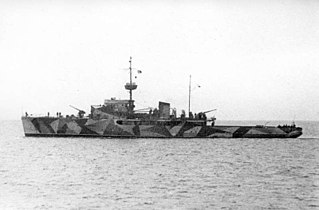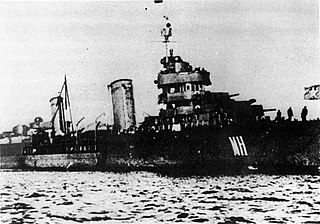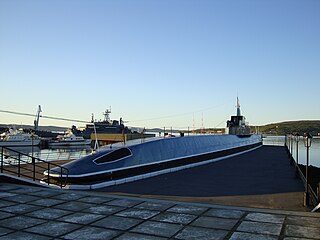
The Hunt class was a class of escort destroyer of the Royal Navy. The first vessels were ordered early in 1939, and the class saw extensive service in the Second World War, particularly on the British east coast and Mediterranean convoys. They were named after British fox hunts. The modern Hunt-class GRP hulled mine countermeasure vessels maintain the Hunt names lineage in the Royal Navy.
Storozhevoy was the lead ship of her class of 18 destroyers built for the Soviet Navy during the late 1930s. Although she began construction as a Project 7 Gnevny-class destroyer, Storozhevoy was completed in 1940 to the modified Project 7U design.

The six Leningrad-class destroyer leaders were built for the Soviet Navy in the late 1930s. They were inspired by the contre-torpilleurs built for the French Navy. They were ordered in two batches of three ships each; the first group was designated Project 1 and the second Project 38. These ships were the first large vessels designed and built by the Soviets after the October Revolution of 1917.
The Pravda class or P-class submarines were built for the Soviet Navy in the mid-1930s. They originally served as training ships, then later served in World War II for mainly transport duties. They were intended to operate with the surface fleet but failed to meet specifications, particularly for surface speed. The initial design envisaged 130 mm (5.1 in) guns for surface action. These boats had a long building time, being laid down in 1931 and completed in 1936.

UD-5 was an O 21-class submarine. The boat was laid down as the Dutch submarine HNLMS K XXVII and renamed HNLMS O 27 but was captured during the German invasion of the Netherlands in World War II and commissioned in the Kriegsmarine. The ship survived the war and was returned to the Netherlands where she served under her old name until 1959.

Gremyashchy was one of 29 Gnevny-class destroyers built for the Soviet Navy during the late 1930s. Completed in 1939, she was assigned to the Baltic Fleet and was later transferred to the Northern Fleet in 1941.

NMS Amiral Murgescu was a minelayer and convoy escort of the Romanian Navy, the first sea-going warship built in Romania and the largest Romanian-built warship of World War II. She laid numerous minefields, from the Bulgarian port of Burgas to the Crimean port of Sevastopol, which inflicted significant losses to the Soviet Black Sea Fleet. She also carried out numerous convoy escort missions and took part in the Axis evacuation of the Crimea in May 1944. Due to her success in combat, she was decorated twice by May 1944. She was captured by the Soviet Union in September 1944 and served until 1988, when she was scrapped.

Minsk was one of six Leningrad-class destroyer leaders built for the Soviet Navy during the 1930s, one of the three Project 38 variants. Completed in 1939, the ship was assigned to the Baltic Fleet and played a minor role in the Winter War against Finland in 1939–1940. After the start of Operation Barbarossa, the German invasion of the Soviet Union in June 1941, Minsk covered minelaying operations and provided naval gunfire support to Soviet units. She escorted ships during the Soviet evacuation of Tallinn, Estonia, in late August. The ship was sunk by German dive bombers on 23 September, although her wreck was salvaged in 1942 and repaired. Minsk was recommissioned in 1943 but the repairs were not completed until the following year. The ship was reclassified as a training ship in 1951, then became a target ship in 1958 and was sunk that year.

Gnevny was the lead ship of her class of 29 destroyers built for the Soviet Navy during the late 1930s. Completed in 1938, she was assigned to the Baltic Fleet and played a minor role in the 1939–1940 Winter War when the Soviet Union invaded Finland. A few days after the start of the German invasion of the Soviet Union in June 1941, the ship struck a German mine and was badly damaged. After taking off the survivors, the Soviets failed to sink Gnevny with gunfire before they withdrew and the abandoned wreck drifted until she was sunk by German bombers three days later.

Grozny was one of 29 Gnevny-class destroyers built for the Soviet Navy during the late 1930s. Completed in 1938, she was initially assigned to the Baltic Fleet before being transferred to the Northern Fleet in mid-1939 where she participated in the 1939–1940 Winter War against the Finns.

Gromky was one of 29 Gnevny-class destroyers built for the Soviet Navy during the late 1930s. Completed in 1938, the ship was initially assigned to the Baltic Fleet before being transferred to the Northern Fleet in mid-1939 where she played a minor role in the 1939–1940 Winter War against Finland.

Stremitelny was one of 29 Gnevny-class destroyer built for the Soviet Navy during the late 1930s. Completed in 1938, the ship was assigned to the Baltic Fleet and played a minor role in the 1939–1940 Winter War against Finland. Stremitelny was transferred to the Northern Fleet in mid-1940. After the start of the German invasion of the Soviet Union in June 1941, she covered an amphibious landing along the Arctic coast. The ship was attacked and sunk by German dive bombers the following month in Polyarny with the loss of 111 crew and passengers. Her wreck was partially salvaged the following year.

Smetlivy was one of 29 Gnevny-class destroyers built for the Soviet Navy during the late 1930s. Completed in 1938, she was assigned to the Baltic Fleet and played a minor role in the 1939–1940 Winter War against Finland. After the start of the German invasion of the Soviet Union in June 1941, the ship participated in the Gulf of Riga Campaign before withdrawing to Tallinn, Estonia. Smetlivy supported Soviet forces during the defense of Tallinn in August and covered the subsequent evacuation to Leningrad. The ship provided naval gunfire support to the defenders of Leningrad over the next several months before she was assigned to evacuate Soviet troops from their enclave in Hanko, Finland, in November. Smetlivy struck several mines returning from Hanko and sank with heavy loss of life.

Boyky was one of 29 Gnevny-class destroyers built for the Soviet Navy during the late 1930s. Completed in 1939, she was assigned to the Black Sea Fleet. After the start of the German invasion of the Soviet Union in June 1941, the ship helped to lay minefields off Sevastopol. During the Siege of Odessa, Boyky transported troops and supplies while providing naval gunfire support to the defenders and then helped to evacuate them in October. During the Siege of Sevastopol, she performed the same sorts of missions and then participated in the Battle of the Kerch Peninsula at the end of 1941.

Razyaryonny was one of 29 Gnevny-class destroyers built for the Soviet Navy during the late 1930s. Originally named Peredovoy, she was renamed Razyaryonny before completion in late 1941, and was assigned to the Pacific Fleet.

Razumny was one of 29 Gnevny-class destroyers built for the Soviet Navy during the late 1930s. Originally named Prochny, she was renamed Razumny before completion in 1941, and was assigned to the Pacific Fleet. About a year after the German invasion of Russia in June 1941, she was ordered to join the Northern Fleet, sailing through the Arctic Ocean. Together with several other destroyers, Razumny left the Soviet Far East in July 1942 and arrived in Murmansk three months later where she began escorting convoys, both Allied ones from Britain and the United States and local ones in the White and Barents Seas. The ship was badly damaged by German bombs while she was refitting in 1943 and was under repairs for five months. Razumny spent most of the rest of the war on convoy escort duties, although she did bombard a German-occupied town during the Petsamo–Kirkenes Offensive of October 1944.
Stoyky was one of 18 Storozhevoy-class destroyer built for the Soviet Navy during the late 1930s. Although she began construction as a Project 7 Gnevny-class destroyer, Stoyky was completed in 1940 to the modified Project 7U design.










